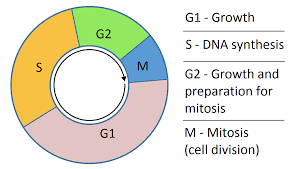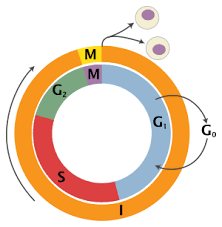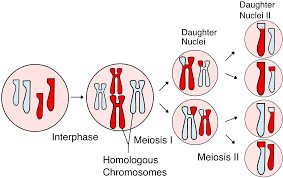Meiosis (Reductional Division)
Definition:- The tem meiosis was coined by Farmar and Moore in 1905. The division was studied by Van Benedin Winiwarter and Strassburger.
Meiosis or meio is “to lessen” , hence meiosis is a double division in which a diploid cell form four haploid cells, each having half the number of chromosomes. Meiosis involves two sequential cycles of nuclear division but only one cycle of DNA replication due to which four haploid daughter cells are formed.
Occurrence:– Only the special cells of sexually reproducing multicellular organisms undergo meiosis, at a specific time in the life cycle.
Meiosis consists of two divisions, i,e Meiosis I and Meiosis II
Meiosis I | Meiosis II |
1. Prophase I | Prophase II |
2. Metaphase I | Metaphase II |
3. Anaphase I | Anaphase II |
4. Telophase I | Telophase II |
(i) Leptotene (Bouquet stage):- Condensation and coiling of chromatin fibres begins to form distinct chromosomes which gradually become visible under the light microscope.
(ii) Zygotene:– Zygotene is the second stage that occurs after leptotene.
(a) A diploid cell contains two sets of chromosomes. The two chromosomes which are similar in form, size, structure are called homologous chromosomes. One of the homologous chromosomes is paternal chromosome and the other is maternal chromosome.
A Meiosis I
It is the reductional division in which the number of chromosomes is reduced to half. It is studied in four stages:-
- Prophase I:- Prophase I is more elaborate, prolonged, complex than prophase of mitosis. Prophase I is further sundivided into five stages, viz. Leptotene, Zygotene, Pachytene, Diplotene and Diakinesis.
(b) During zygotene, these homologous chromosomes start pairing together. These homologous chromosomes come to lie side by side in pairs and this pairing is known as synapsis. The complex formed a pair of synapsed chromosome is called bivalent.
(c) Chromosomes synapsis is accompanied by a structure called synaptonemal complex which is thought to stabilize the two homologous chromosomes till the crossing over completed.
(iii) Pachytene:- It is the third stage that occurs after zygotene,
(a) the chromosomes become still shorter and thicker. During this stage the four chromatids of each bivalent chromosome becomes distinct and clearly appears as tetrads. Genetic material is exchanged between non-sister chromatids of the homologous chromosomes. The process is called crossing over.
(b) The site where crossing over occurs forms a recombination nodule. The recombination is an enzyme- mediated process. An enzyme called recombinase is involved during this process.
(c) By the end of pachytene, the recombination between the homologous chromosomes is complete and the two chromatids are linked at the site of crossing over.
(iv) Diplotene:- Diplotene is the fourth stage. During this stage, the crossing over is completed and the two homologous chromosomes begin to separate from each other.
(a) It is longest phase of prophase I. there is dissolution of synaptonemal complex, so the homologous chromosomes will start separating i.e.desynapsis. The separation of the homologous chromosomes is not completed. They remain attached at one or more points where crossing over has occurred. These points of attachment are called Chiasmata, which are seen as X-shaped structures.
(b) In oocytes of some vertebrates, diplotene lasts for month or years. It is called dictyotene stage i.e suspended diplotene stage.
(c) Terminalisation of chiasma starts in this stage.
(v) Diakinesis:- It is the final stage of prophase I. It represents transition to metaphase I.
(a) Spindle assembles to prepare homologous chromosomes for separation.
(b) Terminalisation of chiasmata:- Due to tight condensation of chromosomes, the chiasmata disappear from the chromosomes by slipping off or slipping from the tip of the chromosomes
(c) Nucleolus disappears and the nuclear envelop disintegrates.

- Metaphase:- Due to disintegration of nuclear envelop the chromosomes move into the cytoplasm.
(i) The bivalent chromosomes align themselves on the equatorial plate. The centrmeres of the two chromosomes are arranged in two rows at the equator. So double metaphasic plate is formed.
(ii) The distribution of the bivalent chromosomes are at random. There is no fixed direction in which paternal or maternal chromosomes would face.
(iii) The microtubules of the spindle fibresfrom opposite poles attach to the centromere of the chromosome facing towards it.
- Anaphase:- The two chromosomes of each bivalent separate from one another and start moving towards the opposite poles, there is no division of the centromere. Thus only one one chromosome of each homologous pair reaches each pole. Consequently the nucleus of each daughter cell gets only half the number (haploid) of chromosomes present in the original cell. Thus, reduction in the number of chromosomes occurs during anaphase-I.
- Telophase I:- It is the final stage of reductional division e.g meiosis.
(i) The chromosomes reach the poles. The spindle fibres completely disappear.
(ii) The nucleous and nuclear membrane reappear.

(iii) The chromosomes uncoil and elongate but remain straight in this phase. They do not reach the extremely extended state of the interphase nucleus.
(iv) It produces two daughter nuclei, each containing half the number of chromosome but double the amount of nuclear DNA as both the chromatids move together to a single pole. The separation of these two chromatids occurs during meiosis II.

Cytokinesis:- It is generally follows the first nuclear division, so two daughter cells are formed which are haploid.
Interkinesis or Intrameiotic Interphase
Interkinesis or intrameiotic intrphase is a metabolic stage between telophase I and prophase II. It is a gap with exists between meiosis I and meiosis II. During this phase, the chromosomes are elongated but do not form chromatin fibres. There is no replication of DNA during this phase, but centrioles pairs replicate in animals cell. The RNA and protein required during meiosis II are synthesize during this phase.
B Meiosis
Meiosis II is similar to metosis, i.e equational division, but not an exact copy of mitosis because mitosis occurs in diploid somatic cell but meiosis II always occurs in haploid germ cells. Mitosis is always followed by DNA replication, but meiosis II is not followed by DNA replication. The daughter cells formed after meiosis II are neither similar to each other nor similar to the parent cell. The main event which occurs during meiosis II is the separation of the chromatid of the univalent chromosomes present in the daughter cells formed after meiosis I. The chromatids present in the univalent chromosome differ from each other due to crossing over. Meiosis II is divided into four phases, namely- prophase II,Metaphase II, AnaphaseII and Telophase II.
Prophase II:- Prophase II is not long and complicated as prophase I. It is a short phase where the chromatids of the univalent condenses. The chromatin material again becomes compact. The nucleous and nuclear envelope disintegrate and disappear.
Metaphase II:- The univalents, i.e chromosomes align themselves at the equator, (on equatorial plane) in the metaphase II. The microtubules from the opposite pole extend towards the equator and attached at the kinetochore of the chromatids.
Anaphase:- During this phase, the centromere holding the two chromatids splits and allow the separation and movement of the two chromatids the opposite poles of the cell by shortening of microtubules attached to kinetochores.
Telophase II:- This is the last stage of meiosis II. During this phase, the chromatids reach the poles and start uncoiling. They decondense and become thin. The spindle fibres degenerate. The nuclear membrane and nucleous reappear and four haploid nuclei are formed. The telophase II is now followed by cytokinesis which divides the cytoplasm and forms four individual haploid cells.

Cytokinesis II:- Each daughter cell of meiosis I divides to form twodaughter cells and hence at the end of meiosis, i.e after meiosis I and meiosis II, a diploid cell gives rise to four haploid daughter cells.
Significance of Meiosis:–
- Formation of gametes:- Meiosis produces gametes for sexual reproduction.
- Maintenance of chromosomes number:- Meiosis reduces the chromosome number to falf in the gametes, so that fertilization restores the original diploid number in the zygote.
- Introduction of variations:- Meiosis provides a chance for the formation of new combinations of chromosomes. This brings out variations.
- The cell cycle is the series of events that cells go through as they grow and divide. It consists of interphase (G1, S, G2 phases) and the mitotic phase (mitosis and cytokinesis).
- The main phases are:
- G1 phase (Gap 1): Cell growth and preparation for DNA replication.
- S phase (Synthesis): DNA replication.
- G2 phase (Gap 2): Preparation for mitosis.
- M phase (Mitosis): Division of the cell’s nucleus followed by cytokinesis, the division of the cytoplasm.
- Mitosis is the process of nuclear division in eukaryotic cells that results in two daughter cells, each with the same number of chromosomes as the parent cell. It consists of prophase, metaphase, anaphase, and telophase.
- Mitosis produces two genetically identical daughter cells for growth and repair, while meiosis produces four genetically diverse gametes (sperm or eggs) for sexual reproduction, each with half the number of chromosomes of the parent cell.
- Cytokinesis is the process of dividing the cytoplasm of a parental cell into two daughter cells, occurring after the completion of mitosis or meiosis.